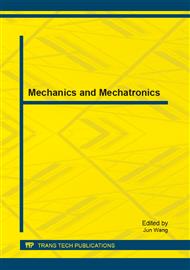p.228
p.235
p.240
p.244
p.250
p.258
p.264
p.269
p.273
Kinematics Analysis of Multi-Functional 4-DOF Mechanical Arm
Abstract:
In order to reduce the complexity of the mechanical arms positive and inverse kinematics equations solving process, find the closed analytical solutions of the inverse kinematics equation quickly and accurately, establish four degrees of freedom mechanical arm positive and inverse kinematics equations based on the four degree of freedom mechanical arms analysis theory and the theory of homogeneous transformation matrices. The kinematics equation gives the relationship of space and posture position between the mechanical arms motion artifacts and the end executor, enabling robotic mission movement according to the predetermined position sequence. In this paper, with a kind of multi-functional mechanical arm as an example, describes the way of building the kinematics model of the articulated robot, which have important reference value to the development of this type of robot system.
Info:
Periodical:
Pages:
250-257
Citation:
Online since:
October 2013
Authors:
Keywords:
Price:
Сopyright:
© 2013 Trans Tech Publications Ltd. All Rights Reserved
Share:
Citation:


